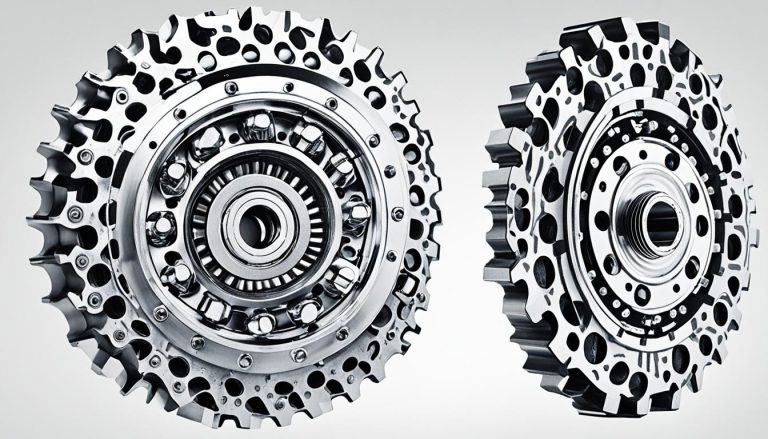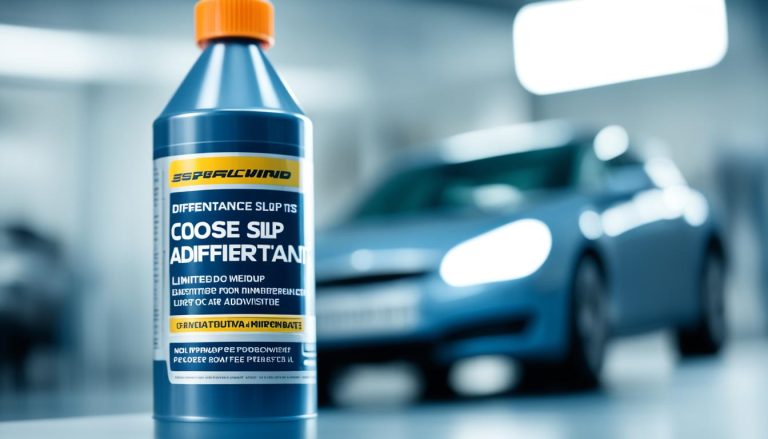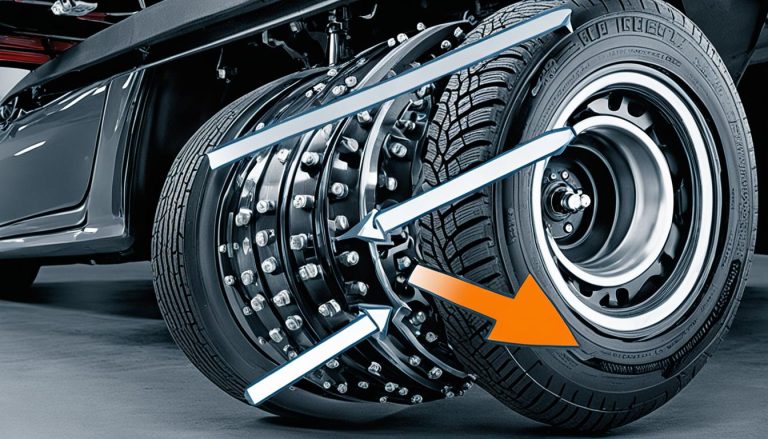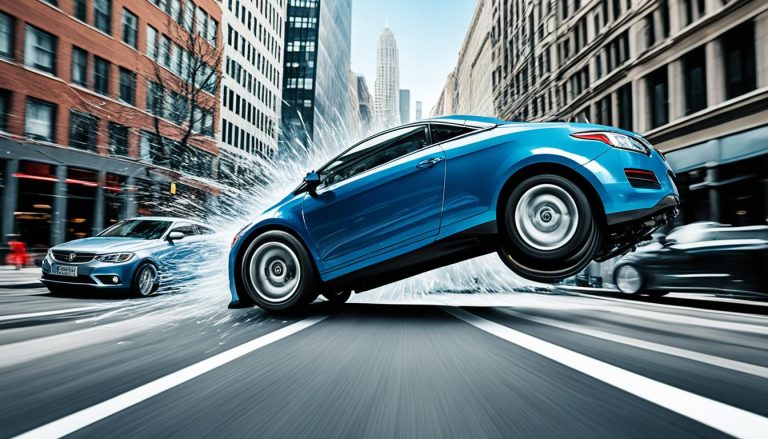Understanding 3.55 Rear Axle Limited Slip
If you’re a car enthusiast or someone interested in understanding the technicalities of vehicle performance, you may have come across the term “3.55 rear axle limited slip.” But what exactly does it mean? Let’s delve into the world of rear axles and limited slip differentials to understand this concept better.
A 3.55 rear axle limited slip refers to a specific gear ratio of the rear differential ring and pinion. The limited slip feature is what allows both wheels to turn at the same time, providing improved traction. This is a desirable feature for many vehicle owners as it enhances the vehicle’s performance and handling, especially in situations where there may be a loss of traction.
Key Takeaways:
- 3.55 rear axle limited slip involves a specific gear ratio of the rear differential ring and pinion.
- The limited slip feature allows both wheels to turn simultaneously, improving traction.
- It enhances vehicle performance and handling, particularly in situations with a loss of traction.
What is a 3.55 Rear Axle Ratio?
The 3.55 rear axle ratio is a fundamental component of a vehicle’s drivetrain, specifically related to the gear ratio in the rear differential. This ratio indicates the number of times the driveshaft turns in relation to one revolution of the rear tires.
The 3.55 ratio signifies that the driveshaft turns 3.55 times for each full rotation of the rear tires. This gear ratio plays a crucial role in determining the vehicle’s performance characteristics, particularly in terms of acceleration and pulling power.
The gear ratio of a 3.55 rear axle has an impact on the vehicle’s overall performance and capabilities.
Higher gear ratios, such as the 3.55, typically provide better low-end pulling power and acceleration. However, they do come with a trade-off when it comes to top speed. The higher the gear ratio, the slower the vehicle’s top speed potential.
The rear differential is where the gear ratio is set, and it is responsible for transmitting the torque from the driveshaft to the rear wheels. It consists of a ring and pinion gear arrangement that allows for the proper distribution of power to the wheels.
The following table provides a comparison of different gear ratios, including the 3.55 rear axle ratio, to illustrate their performance characteristics:
| Gear Ratio | Performance Characteristics |
|---|---|
| 3.55 | Improved low-end pulling power and acceleration |
| 4.10 | Even better low-end torque and acceleration, further sacrificing top speed |
| 3.08 | Higher top speed potential, but reduced low-end torque and acceleration |
The gear ratio is a critical factor in determining a vehicle’s performance, with different ratios offering varying strengths and compromises.
Limited Slip vs. Non-Limited Slip Rear Axle
A limited slip rear axle, as the name suggests, has a mechanism that limits the slip between the rear wheels, allowing for better traction and control. This is achieved through the use of clutches or other friction-based mechanisms that distribute torque evenly to both wheels.
On the other hand, a non-limited slip rear axle does not have this mechanism and allows for independent wheel movement. The absence of a limited slip mechanism means that when one wheel loses traction, the other wheel may not receive the necessary torque to maintain control and traction.
A limited slip rear axle can be particularly beneficial in situations where traction is essential, such as off-road driving or navigating slippery road conditions. By distributing torque evenly to both wheels, a limited slip rear axle helps prevent wheel spin and ensures power is delivered to both wheels, providing better traction and stability.
The choice between a limited slip rear axle and a non-limited slip rear axle depends on the specific vehicle and its intended use. Vehicles that require enhanced traction and stability, such as sports cars or off-road vehicles, often come equipped with limited slip rear axles. On the other hand, vehicles designed for regular road use may have non-limited slip rear axles.
To summarize:
| Limited Slip Rear Axle | Non-Limited Slip Rear Axle |
|---|---|
| Includes a mechanism to limit slip between rear wheels | Does not have a mechanism to limit slip between rear wheels |
| Improves traction and control | Allows for independent wheel movement |
| Beneficial in off-road or slippery road conditions | Suitable for regular road driving |
Ultimately, the presence or absence of a limited slip rear axle can significantly impact a vehicle’s performance, especially in situations where maintaining traction and control is essential.
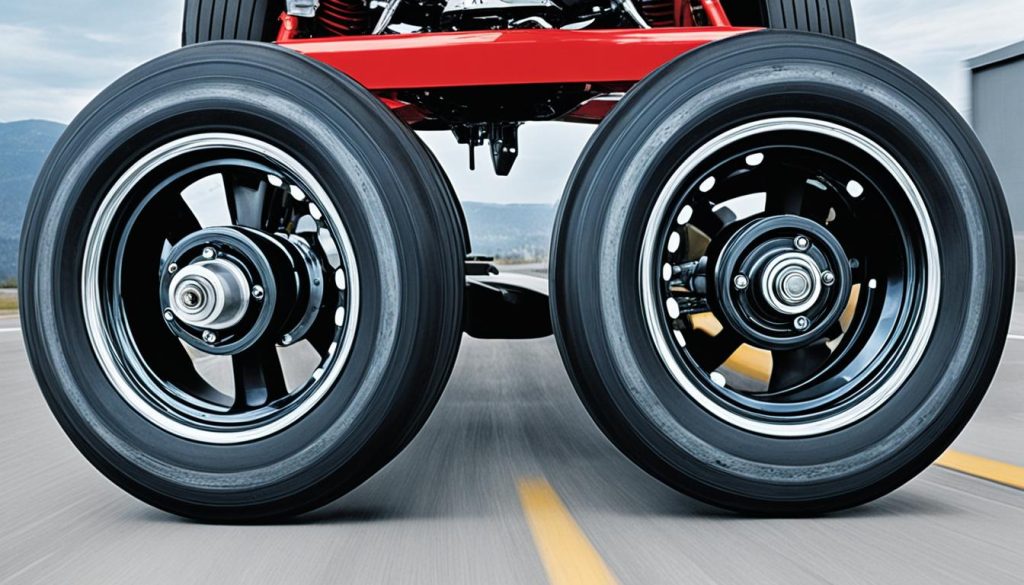
Benefits of Limited Slip Rear Axle
A limited slip rear axle offers numerous benefits that significantly enhance your driving experience. The key advantage of this feature is the improved traction and performance it provides. By distributing torque evenly to both rear wheels, a limited slip rear axle ensures better acceleration, especially when one wheel is slipping or losing traction.
- Enhanced Traction: In challenging conditions such as off-road driving, snowy or icy roads, maintaining traction is essential for safe driving. A limited slip rear axle prevents wheel spin and helps your vehicle maintain grip on the road surface, allowing you to confidently navigate through difficult terrains.
- Better Handling and Stability: The balanced distribution of torque to both rear wheels also improves handling and stability. Whether you’re taking sharp turns or maneuvering through tight spaces, a limited slip rear axle ensures better control and increased stability, enhancing your overall driving experience.
- Optimized Performance: The improved traction provided by a limited slip rear axle directly translates into better performance. Whether you’re looking for quick acceleration or enhanced towing capabilities, this feature allows your vehicle to deliver optimal power to the wheels, resulting in a smooth and powerful driving experience.
If you’re a passionate off-road enthusiast or frequently encounter challenging driving conditions, a limited slip rear axle will undoubtedly enhance your vehicle’s capabilities. Whether it’s conquering rough terrains or maintaining control on slippery surfaces, the benefits of a limited slip rear axle go beyond improved traction and performance, offering you enhanced safety and confidence on the road.

How Does a Limited Slip Rear Axle Work?
A limited slip rear axle utilizes a mechanism, such as clutches or friction plates, to limit the slip between the rear wheels, resulting in improved traction and control. When one wheel starts to lose traction and spin, the limited slip mechanism intervenes and applies torque to the opposite wheel, allowing it to maintain traction and preventing the loss of control.
This mechanism can be either mechanical or electronic, depending on the design of the vehicle. Mechanical limited slip differentials use friction-based components that engage and distribute torque to both rear wheels. On the other hand, electronic limited slip differentials utilize sensors and electronic control units to monitor wheel speeds and apply the necessary torque to maintain traction.
“The limited slip mechanism ensures that power is distributed effectively to both rear wheels, providing improved traction and stability.”
The precise workings of a limited slip rear axle can vary depending on the manufacturer and model. However, the underlying goal remains the same – to enhance traction and overall performance, particularly in challenging driving conditions such as slippery roads, off-road terrains, or sharp turns.
Pros of a Limited Slip Rear Axle:
- Improved traction and control
- Enhanced performance, especially in challenging driving conditions
- Better acceleration and stability
- Reduced risk of wheel slippage and loss of control
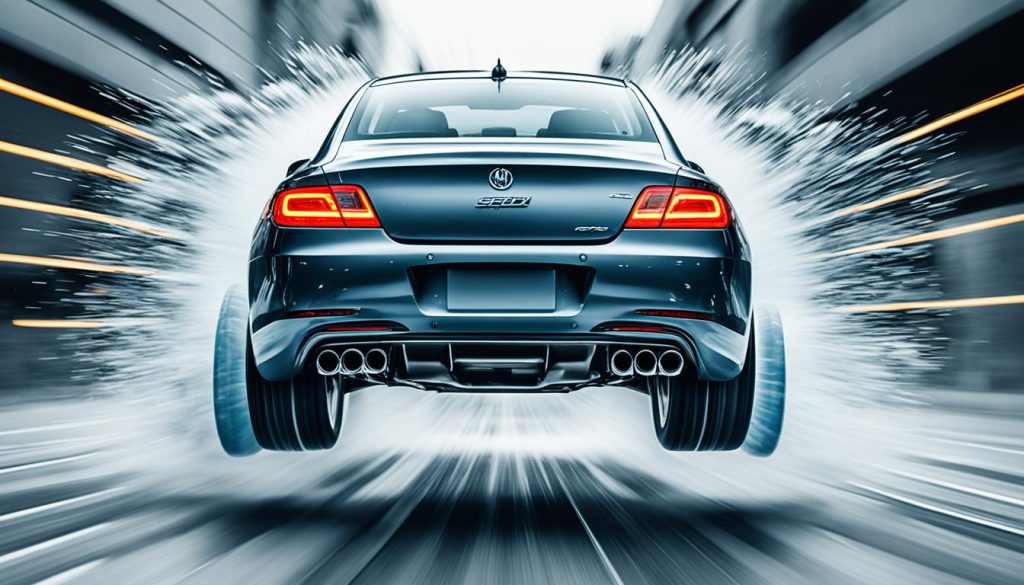
Overall Mechanism:
| Mechanism | Description |
|---|---|
| Clutches or friction plates | Engage to limit wheel slip and distribute torque |
| Mechanical limited slip differential | Uses friction-based components to distribute torque |
| Electronic limited slip differential | Relies on sensors and control units for torque distribution |
In summary, a limited slip rear axle employs a specific mechanism to limit wheel slip and optimize traction. This results in improved stability, control, and overall performance, making it a desirable feature for many drivers.
Differentiating Gear Ratios: 3.55 vs. 3.73
When it comes to gear ratios, the distinction between a 3.55 axle ratio and a 3.73 axle ratio is essential. Understanding the difference can help you make an informed decision about which option is best suited for your vehicle’s performance needs.
The gear ratio refers to the number of revolutions the driveshaft makes compared to the rear axle. With a 3.55 axle ratio, the driveshaft will turn 3.55 times for each revolution of the rear tires. On the other hand, a 3.73 axle ratio means that the driveshaft will turn 3.73 times for each revolution of the rear tires.
The disparity in gear ratios directly impacts the vehicle’s performance. A 3.73 axle ratio offers better low-end pulling power and acceleration compared to a 3.55 ratio. This means that with a 3.73 ratio, you can expect enhanced towing capabilities and improved performance when accelerating from a standstill.
However, it’s worth noting that opting for a 3.73 axle ratio comes at the cost of fuel efficiency and top speed. Due to the higher gear ratio, the engine will have to work harder to maintain higher speeds, resulting in increased fuel consumption.
| Aspect | 3.55 Axle Ratio | 3.73 Axle Ratio |
|---|---|---|
| Revolution of the Driveshaft per Tire Revolution | 3.55 | 3.73 |
| Low-End Pulling Power | Inferior | Superior |
| Acceleration | Inferior | Superior |
| Fuel Efficiency | Superior | Inferior |
| Top Speed | Superior | Inferior |
It’s important to consider your specific needs and preferences when choosing between a 3.55 axle ratio and a 3.73 axle ratio. If you prioritize towing capacity and low-end power, the 3.73 ratio may be the better choice. However, if fuel efficiency and top speed are key factors for you, the 3.55 ratio might be more suitable.
Remember, selecting the right gear ratio can significantly impact your overall driving experience and the capabilities of your vehicle. So, take the time to evaluate your requirements and consult with a trusted automotive professional who can provide expert guidance tailored to your specific needs.
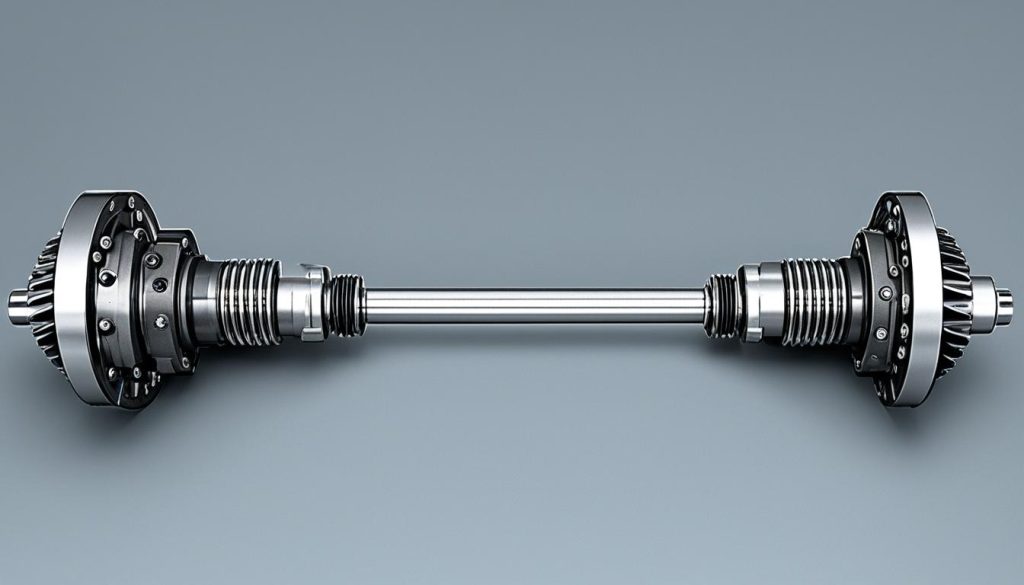
Front Differential and Limited Slip Rear Axle
The front differential and the limited slip rear axle are two crucial components in a vehicle’s drivetrain that work together to optimize traction and power distribution. While they have distinct functions, they play a pivotal role in ensuring a smooth and efficient driving experience.
The front differential is responsible for distributing torque between the front wheels, allowing each wheel to rotate at a different speed while maintaining power transfer. This mechanism is essential for ensuring smooth cornering and maneuverability, especially in vehicles with all-wheel drive or four-wheel drive systems.
On the other hand, the limited slip rear axle functions independently of the front differential and is specific to the rear wheels. It employs a mechanism, such as clutches or friction plates, to limit the slip between the rear wheels and distribute torque evenly. This feature enhances traction and control, particularly in situations where one wheel may be slipping or losing traction.
The connection between the front differential and the limited slip rear axle lies in their shared goal of optimizing torque distribution and traction. While they operate as separate components, they work in harmony to ensure the vehicle can effectively navigate various driving conditions, whether on-road or off-road.
Here is a breakdown of the key characteristics and functionalities of the front differential and the limited slip rear axle:
Front Differential
| Component | Function |
|---|---|
| Torque Distribution | Distributes torque between the front wheels to enable smooth power transfer |
| Independent Rotation | Allows each front wheel to rotate at a different speed during cornering |
| Maneuverability | Enhances vehicle handling and stability, especially in all-wheel or four-wheel drive systems |
Limited Slip Rear Axle
| Component | Function |
|---|---|
| Torque Distribution | Distributes torque evenly between the rear wheels to optimize traction |
| Slip Limitation | Limits the slip between the rear wheels, reducing the chance of one wheel losing traction |
| Traction Enhancement | Improves acceleration and control in challenging driving conditions |
The combination of a front differential and a limited slip rear axle ensures optimal power distribution and traction, resulting in enhanced vehicle performance and handling. Whether you’re navigating through slippery roads or tackling off-road terrains, these components work in tandem to provide you with a safe and confident driving experience.
Emphasize your vehicle’s potential with a front differential and a limited slip rear axle, offering seamless torque distribution and improved traction. Experience the perfect balance between power and control, whether on the road or off the beaten path.
Adding Electronic Rear Locker
If you’re looking to enhance the traction and performance of your vehicle with a limited slip rear axle, consider adding an electronic rear locker. This aftermarket option can provide maximum traction by mechanically locking the rear wheels together, ensuring that both wheels receive equal torque. Whether you’re an off-road enthusiast or need improved traction in challenging terrain, an electronic rear locker can make a significant difference in your vehicle’s capabilities.
It’s important to note that adding an electronic rear locker may require modifications to your vehicle’s drivetrain. To ensure proper installation and compatibility, it is recommended to consult with a professional. They will guide you through the process and help you select the right aftermarket option that suits your specific needs and vehicle make and model.
By adding an electronic rear locker to your limited slip rear axle, you can take your vehicle’s performance to the next level. Experience maximum traction and get ready to conquer any terrain with confidence.
FAQ
What is a 3.55 rear axle limited slip?
A 3.55 rear axle limited slip refers to a specific gear ratio of the rear differential ring and pinion. The limited slip feature allows both wheels to turn at the same time, providing improved traction and control.
How does a limited slip rear axle work?
A limited slip rear axle uses clutches or other friction-based mechanisms to limit the slip between the rear wheels. When one wheel loses traction, torque is applied to the opposite wheel, maintaining traction and preventing loss of control.
What are the benefits of a limited slip rear axle?
A limited slip rear axle provides improved traction and performance by distributing torque evenly to both rear wheels. It enhances acceleration, handling, and stability, particularly in challenging conditions like off-road or slippery terrains.
What is the difference between a 3.55 axle ratio and a 3.73 axle ratio?
The difference lies in the number of revolutions the driveshaft makes compared to the rear axle. With a 3.55 axle ratio, the driveshaft turns 3.55 times for each revolution of the rear tires, while a 3.73 ratio results in 3.73 turns. The ratio affects the vehicle’s performance and power delivery.
How does a limited slip rear axle differ from a non-limited slip rear axle?
A limited slip rear axle has a mechanism to limit wheel slip and distribute torque evenly to both wheels. In contrast, a non-limited slip rear axle allows for independent wheel movement. The choice between the two depends on the vehicle and its intended use.
How does a limited slip rear axle connect with the front differential?
The limited slip rear axle and the front differential are separate components in a vehicle’s drivetrain. The limited slip rear axle operates independently of the front differential and is specific to the rear wheels, whereas the front differential distributes torque to the front wheels.
Can I add an electronic rear locker to a vehicle with a limited slip rear axle?
Yes, it is possible to add an electronic rear locker as an aftermarket option to a vehicle with a limited slip rear axle. An electronic rear locker mechanically locks the rear wheels together, maximizing traction in challenging terrains. Professional installation is recommended to ensure compatibility and proper functioning.


